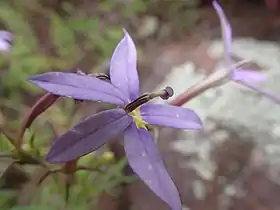Isotoma axillaris
Isotoma axillaris, commonly known as rock isotome or showy isotome,[3] is a small herbaceous perennial in the family Campanulaceae. It usually has blue or mauve star-shaped flowers from September to May. It may also be called blue star, star flower, or laurentia.[2]
| Isotoma axillaris | |
|---|---|
 | |
 | |
| Scientific classification | |
| Kingdom: | Plantae |
| Clade: | Tracheophytes |
| Clade: | Angiosperms |
| Clade: | Eudicots |
| Clade: | Asterids |
| Order: | Asterales |
| Family: | Campanulaceae |
| Genus: | Isotoma |
| Species: | I. axillaris |
| Binomial name | |
| Isotoma axillaris | |
| Synonyms | |
|
Laurentia axillaris, Solenopsis axillaris[2] | |
Description
Isotoma axillaris is an upright perennial herb growing to 50 cm high with ascending stems that are often a purplish colour and covered with short, soft hairs quickly becoming smooth. The leaves are about 1.5–15 cm (0.59–5.91 in) long and 0.5–5 mm (0.020–0.197 in) wide with deep, toothed, linear lobes sharply pointed at the apex. The single blue to mauve, rarely white or pink flowers appear in the leaf axils. The flower throat is occasionally white, greenish or a yellow colour. The five flower lobes are joined to the 15–35 mm (0.59–1.38 in) long flower tube on a peduncle 3–17 cm (1.2–6.7 in) long. The lobes are elliptic to oblong shaped, 8–18 mm (0.31–0.71 in) long, but are not joined and form a star-shaped flower. The seed capsule 7–8 mm (0.28–0.31 in) long. Flowering occurs between September and May in the species native range.[4][5]
Taxonomy and naming
Isotoma axillaris was first formally described by botanist John Lindley in 1826 in Edward's Botanical Register.[6][7] The genus name Isotoma is from the Greek isos meaning "equal" or "like"[8]: 306 and tomos meaning "a part".[8]: 156 The specific epithet axillaris is a Latin word meaning "of an axil",[8] with reference to the flowers borne in the leaf axils.[4]
Distribution and habitat
Showy isotoma occurs in Queensland, New South Wales and Victoria, often in moist crevices on rocky outcrops.[4]
Garden use
I. axillaris is grown as a garden plant. It is winter hardy to about −1 °C (30 °F) (USDA Zone 10). In colder areas, it may be grown as an annual or overwintered indoors.[2]
Gallery
 leaves
leaves habitat
habitat habitat
habitat flower detail
flower detail
References
- "Isotoma axillaris". Australian Plant Census. Retrieved 10 September 2019.
- Missouri Botanical Garden plantfinder, Isotoma axillaris
- "Isotoma axillaris Lindl. Showy Isotome". Flora of Victoria. Royal Botanic Garden Victoria. Retrieved 29 July 2017.
- "Isotoma axillaris". Growing Native Plants. Australian National Botanic Gardens. Retrieved 10 September 2019.
- Fairley, Alan; Moore, Philip (2010). Native Plants of the Sydney Region. Jacana Books. ISBN 978-1-74175-571-8.
- "Isotoma axillaris". Australian Plant Name Index (APNI), IBIS database. Centre for Plant Biodiversity Research, Australian Government, Canberra. Retrieved 23 August 2011.
- "Isotoma axillaris". Biodiversity Heritage Library. Retrieved 11 September 2019.
- Brown, Roland (1956). The Composition of Scientific Words. Washington D.C: Smithsonian Institution Press. p. 90.